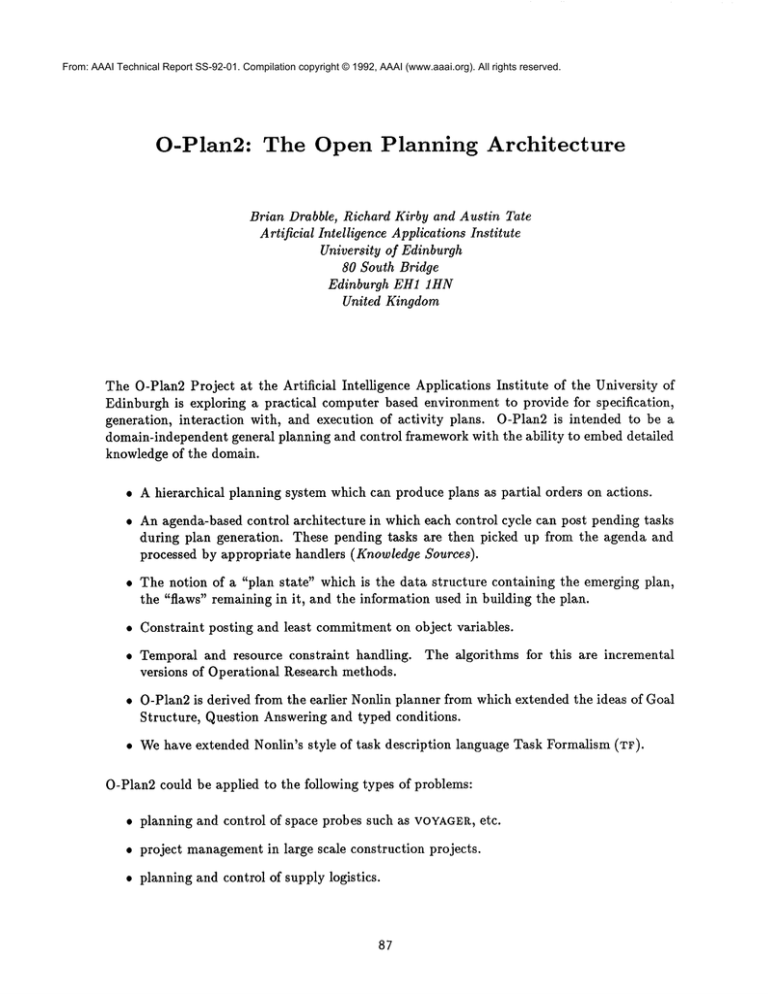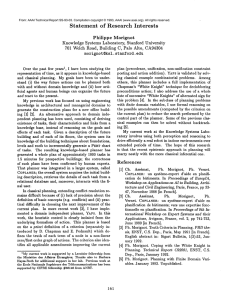
From: AAAI Technical Report SS-92-01. Compilation copyright © 1992, AAAI (www.aaai.org). All rights reserved.
O-Plan2:
The Open Planning
Architecture
Brian Drabble, Richard Kirby and Austin Tate
Artificial Intelligence Applications Institute
University of Edinburgh
80 South Bridge
Edinburgh EH1 1HN
United Kingdom
The O-Plan2 Project at the Artificial Intelligence Applications Institute of the University of
Edinburgh is exploring a practical computer based environment to provide for specification,
generation, interaction with, and execution of activity plans. O-Plan2 is intended to be a
domain-independent general planning and control framework with the ability to embed detailed
knowledge of the domain.
¯ A hierarchical
planning system which can produce plans as partial orders on actions.
An agenda-based control architecture in which each control cycle can post pending tasks
during plan generation. These pending tasks are then picked up from the agenda and
processed by appropriate handlers (Knowledge Sources).
¯ The notion of a "plan state" which is the data structure containing the emerging plan,
the "flaws" remaining in it, and the information used in building the plan.
¯ Constraint posting and least commitmenton object variables.
¯ Temporal and resource constraint handling. The algorithms for this are incremental
versions of Operational Research methods.
¯ O-Plan2 is derived from the earlier Nonlin planner from which extended the ideas of Goal
Structure, Question Answering and typed conditions.
¯ Wehave extended Nonlin’s style of task description
language Task Formalism (TF).
O-Plan2 could be applied to the following types of problems:
¯ planning and control of space probes such as VOYAGER,, etc.
¯ project managementin large scale construction projects.
¯ planning and control of supply logistics.
87
The Scenario
¯ A user specifies a task that is to be performed through some suitable interface.
this process job assignment.
Wecall
¯ A planner plans and (if requested) arranges to execute the plan to perform the task
specified.
¯ The execution system seeks to carry out the detailed tasks specified by the planner while
working with a more detailed model of the execution environment.
~o~ol
~o~o,
I
I Oom~
~.or--(
~o~o~
)’
(~,on~r)~o~m~¢.~,on~xeCSy.~o
~.Wor,~
Planner
Job Req
Capability
~
~xec Syste~
[ Domain
/
Reporting
[
~
Model
/
q
[ Plan State ]
Plan State
NN’~
f
/Input
h"~-’-"
Real
] Plan State [
Figure 1: Communication between Central Planner and Ex. Agent
Wehave deliberately simplified our consideration to three agents with these different roles and
with possible differences of requirements for user availability, processing capacity and real-time
reaction to clarify the research objectives in our work.
A commonrepresentation is sought to include knowledge about the capabilities of the planner
and execution agent, the requirements of the plan and the plan itself either with or without
flaws (see Figure 1).
88
~
ONTROLLER)
DOMAIN
INFO RMATION
]Ct
I PLAN
BIND
NETWORK
ADD
A VARIABLE
¯
A LINK
1
¯
TOME
¯
GOST
¯
¯
I
1
SATISFY
ACONDITION
I
]
¯
PROCESS
SCHEMAS
¯
RESOURCE
DEFINITION
RESOURCE
USAGE
TIME
WINDOWS
KNOWLEDGE
SOURCES
I
I
¯
TASK
¯ DEFINITION
___~
.
¯
AGENDAS
OPERATOR
SCHEMAS
CONSTRAINTS
(STATIC)
(Flaws)
/
SUPPORT
¯ TOME/GOST
MANAGER
¯ QUESTION
¯ TIME
INPUT
EVENTS
¯ c
PLAN
ANSWERING
POINT
STATE
¯ RESOURCE
TOOLS
NETWORK
MANAGER
VARIABLES
MANAGE1
MANAGER
INSTRUMENTATION
AND
¯
SUPPORT TOOLS
¯
EVENT
MANGER
Figure 2:O-Plan2 Architecture
89
P
OUTPUT
EVENTS
Developer
Interface
O-Plan2 is implemented in CommonLisp on Unix Workstations with an X-Windowsinterface.
It is designed to be able to exploit multi-processors in future and thus has a clear separation
of the various components (as shown in Figure 2). Each of these may be run on a separate
processor and multiple platforms maybe provided to allow for parallelism in knowledge source
processing. A sample screen image as seen by the O-Plan2 developer or an interested technical
user is shownin Figure 3.
KSFlatl’onn-1 DEBUG
window
Figure 3: Example Developer Interface
9O
for the O-Plan2 Planning Agent
User Interface
AI planning systems are now being used in realistic applications by users who need to have
a high level of graphical support to the planning operations they are being aided with. An
interface to AutoCAD
has been built to showthe type of User Interface we envisage (see Figure
4). The lower windowdraws the plan as a graph, and the upper right windowcan be useed for
simulations of the state of the world at points in the plan.
"’-
IJJ
: ~na11
~ma,
P!~!~’
-~ " ~!i~!.’ ....
I I IUUII
~1Layer 0 Sn~
270,00,-110.00
iHonLln TF Work~totlon IntlrPmol- 00 WOUwmnt~l Put NL~ TF File
2 Put Goml Sohmm
3 Get Riiult Network
4 Get RotLonI Onlw Reo~lt Network
5 Get CrLtioal Path Data
6 Gaol 5truoture - Conditions
7 Teble oF Hultiple EFFects - EFFects
Context entPlee ueed in plan - UtewhenI
8 Initial
9 Context at ¯ particular node - Simulation
r~pe I to 9. <lplOl> For nonezJ
DL: (~ AutoC~ ia
SETUP
BLOCKS
DIH:
DISPLAY
DR~
EDI’T
IN~JIRY
LAYER:
SETTINGS
PLOT
UCS."
UTILITY
ASIt~E
C0nl~nd:redra~
Conmnd:
(O-~lan/Honltn ~) (TF Input
.lylr O Snap
DL: 1~ AutoC~
4120.00,1990.00
SETUP
BLOCKS
~IM:
DISPLAY
EP~l"
IH(~JIRV
lAVER:
SE’r~NGS
PLOT
U~5:
UTILITY
3D
ASHADE
SA~E:
Commmd:redr~
Co.mend:redr~
Com4,nd:
Figure 4: Example Output of the AutoCAD-basedUser Interface
91



